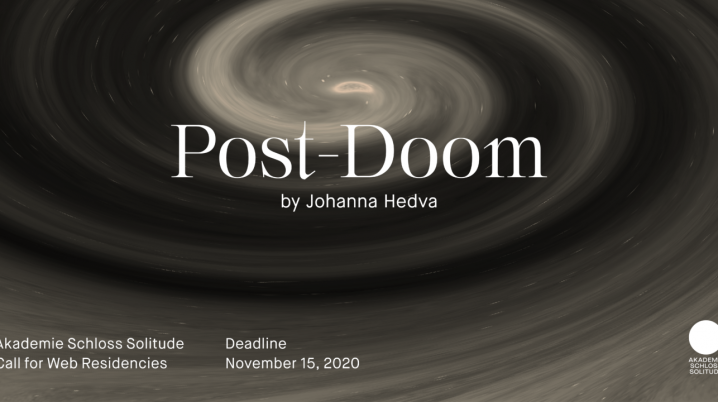
Call for Web Residencies No 14: Post-Doom
For Akademie Schloss Solitude’s Call for Web Residencies No. 14, they invited artist and musician Johanna Hedva as curator. For each call, the curator selects four project proposals, whose creators are rewarded with a four-week residency and 750 euros. All selected Web Residents are nominated for the production prize HASH by Solitude which will be awarded in 2022.
Moving away from all-encompassing dystopian future scenarios, »Post-Doom« explores how the perception of a lost present is inscribed in and reproduced in our everyday experiential spaces. As a seductive counterpart to this seemingly hopeless approaching terminal state (or standstill), Hedva calls for us to rethink beginnings, new multiple entry points, and experiences that reveal the longing for a whole, unmediated potential of our present and future.
Introduction from the curator: I started thinking about doom recently because I was explaining to a friend the difference between death metal and doom metal. »Death is fast, doom is slow,« I said. I realized that when we speak of death, it’s often scaled to the individual, but doom is always scaled hugely, collectively: »We are doomed,« »Earth is doomed,« etc. The twenty-first century is marked by doom – the climate crisis, the promise that this is »late« capitalism (if only!), that liberalism is dead or dying. In 2020 we’ve found ourselves weathering many kinds of doom – disease, fascism – the apocalypse is here. We’ve killed the earth; we keep killing ourselves.
What comes after doom? And what does doom begin? How has it already mutated us? Think of Mark Fisher’s assertion that it’s easier to imagine the end of the world than the end of capitalism. Is this imagining now upon us? Or has it already been here for a while? What happens when we think of doom as a beginning, rather than an end? To start from the position that, of course we are doomed – so, now what? Or, does doom foreclose linearity at all? Is it always ongoing and happening everywhere, and if so, what does such a condition produce as a future, or as a past?
One of the generative threads here is thinking through accessibility, which is particularly relevant in the present transformation COVID-19 has wrought on the world. Under ableism, disability is often called »a fate worse than death.« But for many, disability justice and crip theory are emancipatory politics, a means of abolishing the pernicious ideologies – from racism and colonial-imperialism, to homo- and transphobia – that form the bedrock of patriarchal capitalism, because ableism is at the heart of oppressions that are based on an invented hierarchy of superiority and normativity. This year, I’ve been interested in what I call »the blast radius of disability,« a term that describes the period of time that detonates around illness and disability, when perspectives of our individual selves and capacities mutate, as do our understandings of time and productivity, and our interdependencies with the systems in which we are entangled.
Accessibility is a host for considerations of how we experience and participate in social life: it ranges from disability access (if a building is wheelchair accessible, if a video has subtitles), to concerns of who, and how, people can physically attend an event or place, which is to say, who is allowed and supported to appear in the political space of the public. There is an inherent value with which this presence/absence binary is bound, and accessibility asks after the political consequences of such value. It asks about anywhere, who is not here, and why. Integrating accessibility into work from the beginning, rather than thinking about it at the end, produces new and evocative layers of meaning, multiple entry points and experiences. It pushes against the notion that art is best experienced in person, within a designated space for art, especially germane to consider when applying to a Web Residency.
Applicants should discuss accessibility in their proposals explicitly. For example, if a project contains an online component, applicants should explain how they plan to engage with the WCAG (web content accessibility guidelines). If work is predominantly audio, applicants should explain how they will ensure access for the Deaf and hard-of-hearing community.
They invite artist, healers, astrologers, dancers, musicians, alchemists, writers, and everybody who is willing to explore notions of new beginnings to apply. What if doom is a beginning, rather than an end? And who has access to this new beginning? They accept text, performance, 3D objects, net sculptures and installations, web archives, apps, and any other experimental mediums. Selected projects should be carried out in open-source formats that are well-documented, shareable, and consider the accessibility of its users, who may range in age, race, gender, economic class, and ability.
Deadline for applying is November 15, 2020. Submit your project proposal in the form of:
- a headline
- a concept text in English (1,000–1,500 characters with spaces)
- a header image (high resolution, landscape format)
- a short bio in English (500 characters with spaces)
- a portfolio PDF (images, text, links)

